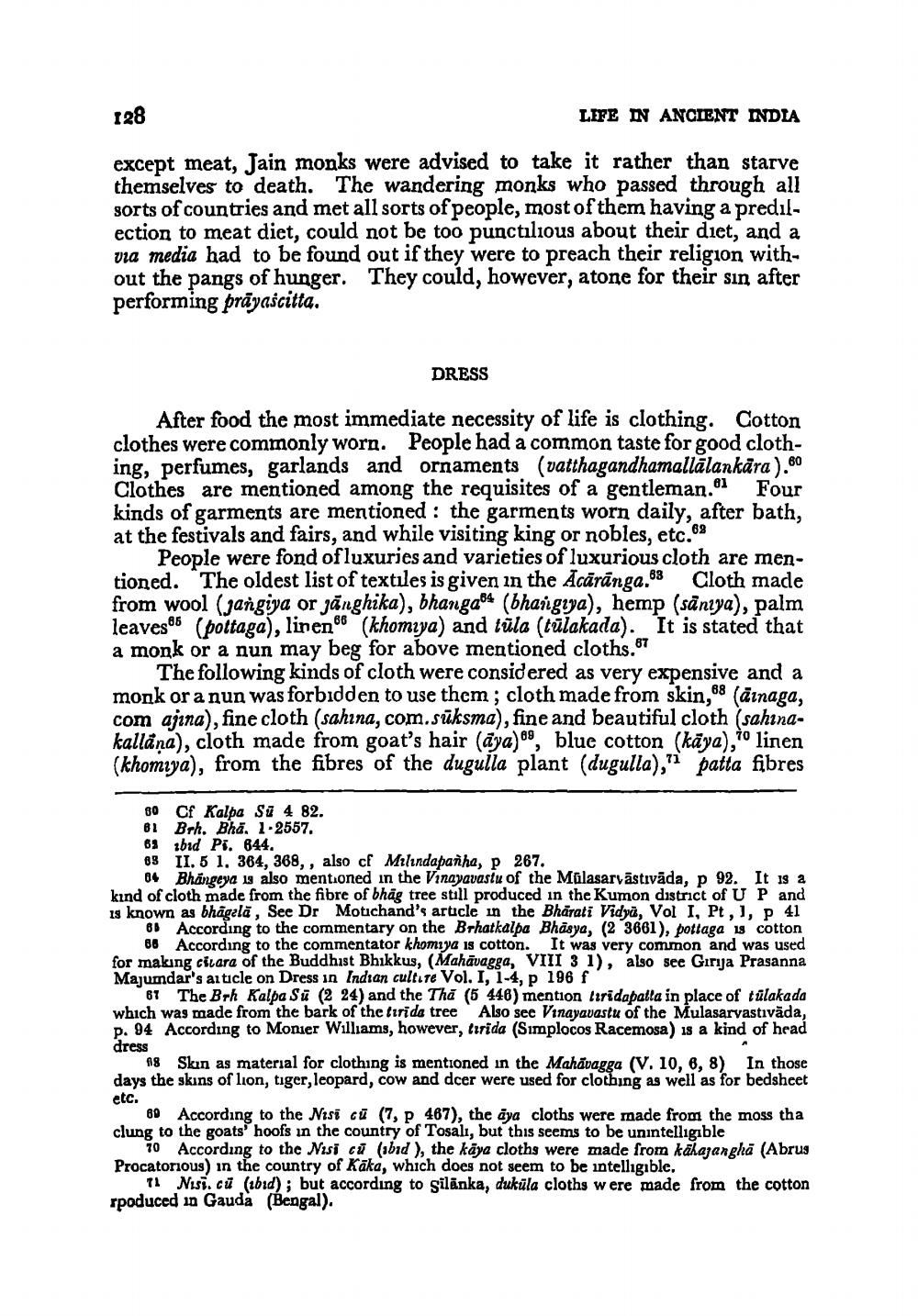________________
128
LIFE IN ANCIENT INDIA
except meat, Jain monks were advised to take it rather than starve themselves to death. The wandering monks who passed through all sorts of countries and met all sorts of people, most of them having a predilection to meat diet, could not be too punctilious about their diet, and a via media had to be found out if they were to preach their religion without the pangs of hunger. They could, however, atone for their sin after performing prāyascitta.
DRESS
After food the most immediate necessity of life is clothing. Cotton clothes were commonly worn. People had a common taste for good clothing, perfumes, garlands and ornaments (vatthagandhamallălankāra).60 Clothes are mentioned among the requisites of a gentleman.61 Four kinds of garments are mentioned : the garments worn daily, after bath, at the festivals and fairs, and while visiting king or nobles, etc. 62
People were fond ofluxuries and varieties of luxurious cloth are mentioned. The oldest list of textiles is given in the Acāranga.63 Cloth made from wool (jangiya or jānghika), bhanga® (bhangiya), hemp (såniya), palm leaves85 (pottaga), linen (khomiya) and tüla (tulakada). It is stated that a monk or a nun may beg for above mentioned cloths.67
The following kinds of cloth were considered as very expensive and a monk or a nun was forbidden to use them; cloth made from skin,68 (ainaga, com ajina), fine cloth (sahina, com.sūksma), fine and beautiful cloth (sahinakallana), cloth made from goat's hair (aya) "9, blue cotton (kāya), 1° linen (khomiya), from the fibres of the dugulla plant (dugulla), patta fibres
80 Cf Kalpa Si 4 82. 81 Brh. Bha. 1-2557. 63 abid Pi. 644. 83 II. 5 1, 364, 368, , also cf Milindapanha, p 267.
04 Bhängeya is also mentioned in the Vinayavastu of the Malasarvästivāda, p 92. It is a kind of cloth made from the fibre of bhag tree still produced in the Kumon district of U P and is known as bhāgelā , See Dr Motichand's article in the Bharati Vidya, Vol I, Pt, ], P 41
88 According to the commentary on the Brhatkalpa Bhäsya, (2 3661), pottaga is cotton
88 According to the commentator khomiya is cotton. It was very common and was used for making citara of the Buddhist Bhikkus, (Mahāvagga, VIII 3 1), also see Girija Prasanna Majumdar's article on Dress in Indian culture Vol. I, 1-4, p 196 f.
67 The Brh Kalpa Sū (2 24) and the Thā (5 446) mention liridapatla in place of tūlakada which was made from the bark of the lirida tree Also see Vinayavastu of the Mulasarvastivāda, p. 94 According to Monier Williams, however, tirida (Simplocos Racemosa) is a kind of head dress
A8 Skin as material for clothing is mentioned in the Mahāvagga (V. 10, 6, 8) In those days the skins of lion, tiger, leopard, cow and dcer were used for clothing as well as for bedsheet etc.
80 According to the Nisi cū (7, p 467), the dya cloths were made from the moss tha clung to the goats' hoofs in the country of Tosalı, but this seems to be unintelligible
70 According to the Nisi cū (ibid), the käya cloths were made from kähajangha (Abrus Procatorious) in the country of Kāka, which does not seem to be intelligible.
Ti Nisi.ců (ibid); but according to silänka, duküla cloths were made from the cotton rpoduced in Gauda (Bengal).




